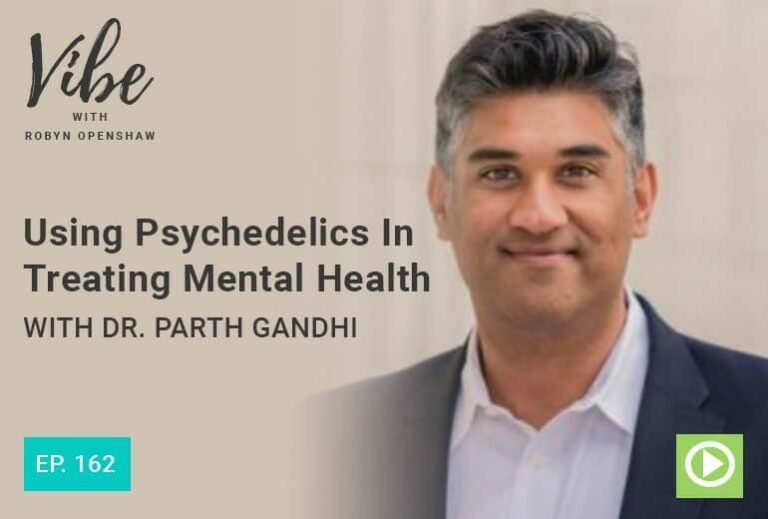Ep. 162: Using Psychedelics In Treating Mental Health with Dr. Parth Gandhi

Podcast: Play in new window
My local friend, neuropsychologist Parth Gandhi, PhD, talks about why he’s excited about ketamine-assisted (using psychedelics) psychotherapy–how it works, and why we shouldn’t be afraid of it.
LINKS AND RESOURCES:
Get 10% off to attend the Intermountain Psychedelics Symposium. Use code: greensmoothie
Get 15% Reduction on Ketamine-Assisted Psychotherapy Packages in the Millcreek office of SCPTR Wellness, mention the podcast.
EPISODE HIGHLIGHTS WITH DR. PARTH GANDHI:
- [04:36] What is a psychedelic, and why should I care? Psychedelics allow for a safe exploration of the mind to promote healing and creativity.
- [09:53] Breakthrough Therapies. New therapy options use psychedelics to break barriers of PTSD and other mental illnesses.
- [14:34] Which psychedelic is being used currently? Ketamine has multiple uses, from anesthesia to anti-suicide.
- [17:51] The science behind the creativity on a psychedelic. Our brains act in a teeter-totter of depression and anxiety. Psychedelics help bring a balance.
- [25:33] Psychedelics are meaning-making drugs. Creating a “safety setting” can bring you meaning and heart opening experiences.
- [30:58] Psychedelics, politics, and pharmacies. Ketamine has been used frequently, but who will mass produce the other psychedelics when they become available?
TRANSCRIPT:
This transcript has been edited for clarity. Robyn: Hey, everyone. It’s Robyn, and welcome back to the Vibe show. Lately, we [have been] digging into some of the controversial topics that my audience tells me they’re really confused about. They’ll ask me, “Do you think CBD is a good idea? Do you think psychedelics are good idea?” I’m still in my own discovery process with both of these topics, but I have a good friend here, locally, whose name is Dr. Parth Gandhi. He reached out and asked to be on the show about psychedelics. He’s on the cutting edge, and he’s ready to bring psychedelics into the treatment of neuropsychology here in Utah. I’ve been curious about it, and I’ve also been very skeptical about it.I told him, “Parth, if I do this interview, I’m going to ask you hard questions.” I have my doubts about bringing in MDMA, what most of us my age think of as some street drug, into the treatment of psychiatry. I’m not against it, but I have my concerns because there’s a lot of money that’s going to be made by the people who bring it in. This interview is going to be pretty hard hitting. I am going to ask him hard questions because he’s excited about it. Dr Gandhi is a neuropsychologist, and he’s researched in a number of areas. He worked with families and youth in distress, [doing] a lot of neuropsychology psychological assessments. He trained at BYU with a world-renowned neuropsychologist — BYU being the university that I taught at for many years. He did some postdoc training at Columbia in New York city, worked with an autistic population, and he’s been the principal investigator on several NIH studies.He’s been really diving into the cognitive social and creative effects of psychedelics on specifically autism and concussion [as well as] addiction and depression. I’ve seen some good research on what psychedelics can do for people with PTSD. We’re going to ask questions today about other applications of psychedelics. The reason I’m interested in it isn’t that I’m interested in promoting a new class of drugs — that is what these are. Let’s make no mistake about it. These are definitely pharmaceuticals, and we [need to] get that straight in our mind. I do trust Parth to dig a little deeper because I’ve been to his yoga class. He teaches yoga, meditation, and mindfulness in Salt Lake City. Sometimes I’ll go down on a Saturday or Sunday and go to his class. He really believes that psychedelics are a significant answer to help awaken the unconscious and help, or even cure, the ill. He’s been a traditional psychologist, but he’s really getting into Ketamine assisted psychotherapy, which I want to know more about. He’s helping people integrate parts of their brain using psychedelics. Welcome to the Vibe show, Dr. Parth Gandhi. Dr. Gandhi: Thank you so much for having me. Robyn: This is going to be fun because I think my audience, when you say the word psychedelics, just transports back to the 70s. Take us through it. What’s a psychedelic, and why should we care? Dr. Gandhi: Wow, why should we care? Psychedelics certainly have the notion of the sixties and seventies and the hippie era and the cult culture of what was going on back in the day. Psychedelics by definition are meaning-making medicines. They allow for mind expansion and the unraveling of unconsciousness and bringing it to the forefront so that we can explore it. “Why should we care” is such a grand question. We’re using psilocybin to study or to treat depression and addiction. MDMA or Molly or ecstasy, as it’s referred to on the street is being used to treat post-traumatic stress disorder with really high effectiveness rates. We’re excited about everything that’s happening in the research world right now and that even government controls are being lifted.Those medicines, psilocybin and MDMA, were reported by the FDA as breakthrough therapies, which means they’re going to be fast tracked through schedule two and three phases with clinical research. Everything that’s happening right now is really exciting and accelerating. Robyn: Talk about schedule one, two, and three. These are the phases of the clinical trial process. Where are psychedelics in that process? Dr. Gandhi: Psilocybin and MDMA are in phase three FDA clinical trials. Most of the phase two clinical trials were completed in the last couple of years. There are about 10 clinical sites across the country — Johns Hopkins in Boulder, Texas. They’re kind of all over. We’re now moving into phase three clinical trials. It’s super exciting to basically be dosing — figuring out how much and how often — and then what the therapy is. That’s really the biggest thing. The medicine has to be integrated with certain kinds of therapy to be effective. MDMA and psilocybin will never be given out like an SSRI, like Zoloft. It’ll always have to be governed in a clinical room in the setting of therapy. Robyn: I’ve been really concerned for a long time about the toxicity — the long term negative health effects — of the benzodiazepines and the SSRIs, which seems to be all that psychology and psychiatry really have to work with in terms of using the actual biochemical state of the body. Obviously there’s talk therapy and many interventions, but in terms of drugs, we’re sort of a fail, aren’t we? Is that why you’re excited about the oncoming potential use of psychedelics? Dr. Gandhi: Absolutely. Looking at the current state of medicine and how we’re treating mental illnesses, [it is] truly disappointing. For those that have treatment resistant conditions — treatment resistant depression, addiction, post-traumatic stress — the efficacy rates of psilocybin — there’s a study from 2012 that suggests up to 78% of those with treatment resistant depression at the six month marker have significant decreases in symptoms of depression. That’s really significant. With MDMA it’s just slightly less — 68% reporting almost a complete remission in those traumatic symptoms. It’s really the process, the coupling of therapy with the medicines and the entire process that I think is really beneficial for the client. Truly it is a change in our paradigm of how to, how we treat mental illness. Robyn: Okay. I know that you talk about ketamine. MDMA is known on the street as Molly or ecstasy. I’m sure that scares some of my followers. I would love for you to talk more about that. Psilocybin, I think is more natural and less like synthetic and isolated. Talk about that and ketamine. Then walk us through the process. How does a therapist use these substances? What do we do once we’re under the influence of these psychedelics? Dr. Gandhi: Let me start with psilocybin, which is a natural occurring substance in magic mushrooms or psilocybin cubensis. These are mushrooms that have grown through millennia — for the longest period of time. There are markers throughout different cultures — in the Greek traditions, in Aztec traditions — where we see that in ceremonial processes. These are used to help people. MDMA is actually a synthesized product. In the 70’s a chemist named Sasha Shulgin created this and several of our other substances.These work on the brain in different ways. The psilocybin works from serotonin receptors. MDMA also — in a different way — works on the serotonin receptors. In terms of your question around therapy, it’s a process of integration. First of all in ceremony or in even a clinic or therapeutic session, we’re setting up a process of safety first. It allows the person to come into their experience. Then we guide them through that experience. With MDMA — if we’re treating PTSD — it’s the opportunity to really experience the trauma from a different mindset, from a safer place. Most people with PTSD don’t allow themselves to experience any of the triggers associated with the trauma. That’s what’s so pervasive about PTSD. It keeps them very, very stuck. The MDMA allows them to re-experience it from a place of mysticism and love. [It is an] opportunity to see themselves from a different point of view. MDMA therapy is actually a very structured protocol. MAPS, the multidisciplinary association of psychedelic sciences, has created a protocol and trains therapists in this process. The essential goals in that are to first create an alliance with the therapist and then create a process of integration with the medicine. Two therapists take the person through on a high dose of the MDMA medicine into what could be a five or six hour therapy session. They guide [the patient] through the same trauma that they’ve been avoiding that’s been so triggering to them. They do that once every month for three months, and then they continue with integrated sessions after that. It’s a very long process and highly effective. Robyn: Okay. One thing I’m worried about is that if there aren’t long term efficacy studies showing what the effects are on people who go through treatment and they use what is a drug, after all. Do we have any long-term studies on any potential negative health effects? What do we know about toxicology on this drug and what possible negatives might be? Dr. Gandhi: That’s a great question. I will first say that most people that use these medicines use a large dose of these medicines, whether it’s psilocybin or LSD or MDMA even other drugs. Most of them don’t want to re-experience that process at such a deep and large level. It’s such a profound experience, but they don’t necessarily want to do it again. There is very little physical addictive qualities. I’m speaking kind of generally [about] all of these medicines, but let’s talk about psilocybin. There is no lethal dose. There’s no point where the medicine can actually kill you, which is, I think, a very, very important thing. LD50 is the term that’s used by the FDA that would effectively kill. [LD50 is] half the dose level that would kill half the population. There literally is no LD50 for psilocybin. That’s not true of the synthetics like MDMA. They’re not addictive. LSD and psilocybin [are] actually less toxic than sugar. That was in a report by the World Health Organization a couple of years ago. Robyn: Interesting. Do you have one that you prefer working with? Are you even able to work with it here in Utah yet, or are you just kind of getting trained and gearing up because you want to be one of the first ones to be able to when that possibility arrives? Dr. Gandhi: That’s a great question. We don’t have a clinical trial site here in Utah yet. At SCPTR, as a nonprofit, we want to establish a place where that can happen here in Utah. There are, I guess, 10 clinical trial sites across the country where they can deliver both MDMA and psilocybin. It’s, as you can imagine, a heavily structured and rigorous [process]. There are actually very few patients that can go through it. What we do have at this point is ketamine. Ketamine has been approved by the FDA for probably 40, 50 years. It has very low toxicity and has traditionally been used as an anesthetic. It’s off-label use for depression has been studied for about the last 20 years, and there’s a lot of very positive things to say. It was actually recently approved by the FDA as an anti-suicide drug in the ER. It’ll immediately take those feelings away from a person. That’s a really important change in what’s going on and how we look at psychedelics and what it can do. Ketamine alone is being delivered at a lot of clinics, but there’s a process called Ketamine Assisted Psychotherapy where we integrate therapy in with the medicine. It’s a two hour session. The first hour a person is in their own mind experiencing the medicine. As they resolve out, they start working with therapist in creating an integration model. What we know from the science is that there’s about a 24 hour period after the medicine is delivered, whether it’s MDMA or psilocybin or ketamine, where there’s a lot more neuro-plasticity, meaning there’s a lot more openness to change and learning and growth. We can kind of reset those ruts in the road and allow a person to look at their experience and they’re learning their habits from a different perspective. Robyn: Interesting. I will go out on a limb here and admit that I did use a psychedelic once, and it was because my brother had been telling me that it’ll change my life. It would fix neurons in my brain. He just insisted. I agreed to do it, and I did it the one time. Within the days afterwards, I felt like I was in this huge creative flow. By the way, I was not doing this with a licensed psychotherapist of any kind. I was doing this as a self-administered thing. I had just this just creative explosion. Over the course of several days, I came up with this whole business idea, and I really shifted courses. I got out of the stuck period of pain and suffering that I was in. I did see those positives. The business model that I pursued — I spent about eight or nine full time months on it — actually failed. It sort of failed before it got off the ground. It did get me out of a rut. What exactly happened there? Dr. Gandhi: That is interesting, and certainly I won’t ask you anything about the specifics. I really appreciate you sharing your story. It makes it easier to describe that. There is often a very creative process that happens with some of these medicines. Our basic statement at Scepter is that we believe in healing the ill and bettering the well with these medicines. It’s not just the mentally ill that are changed by these medicines. It’s pretty well known fact that 50-60% of Palo Alto engineers are micro-dosing LSD or psilocybin. It’s helping them with creativity. There was a study where — in a holographic way — they showed the connections of the brain. There’s one brain on psilocybin and the other is a placebo-controlled brain. You see the strongest connections visually. It’s one of the things that I think really changed the course of what I wanted to study and how I knew we could use these medicines to help people therapeutically. There’s two main results with psilocybin. One is the shutting down of the default mode network, which really creates a lot of rumination in the brain. Now ruminating about the past is what we call depression. Ruminating about the future is what we call anxiety. It allows a presence. The default mode network actually works in sort of a teeter-totter relationship with the attentional network. When we’re paying attention to something and focused on something, the DMN is quieted. When we’re not, and we’re not really engaged in something, the default mode network kind of takes over. It’s that daydreaming process — or ruminating process — that’s telling us what we think about ourselves in the background that can be so debilitating at times. That as well as the strength of the external connections creates a lot more creativity and happiness. Robyn: That’s what I hear. I had always been really scared of it, and it probably took my brother six months of lobbying me to get me to try that. I’ve been in no hurry to do it again. That was several years ago, and I didn’t have any kind of addictive craving to it. It’s not an addictive substance. You’ve touched on that. I have friends and colleagues running off to Peru, and doing this Ayahuasca thing. Is that really healing? They have to just go to Peru because it’s illegal here. A shaman oversees it. What exactly is going on in these Ayahuasca events? Dr. Gandhi: That brings up so many beautiful ideas actually. One is that a lot of these medicines were traditionally given in ceremony. One of the problems is over the last century in especially the Western American culture, we have no context to give this medicine. We have no container to hold people safe in. There is no shamonic principle traditions. You think about the old ways of wisdom traditions, and it was the elders holding space for the younger generation to teach them in a ceremonial setting. It wasn’t an ordinary state, but in non-ordinary state that they knew they were leading people through, to bring them through their hero’s journey. We don’t really have a set process except for therapy now. That is part of why we believe in the psychedelic assisted psychotherapy. Whether it’s psilocybin or MDMA or ketamine, there is a process that’s created for that for that journey. Robyn: You hear about people who had a bad trip, right? My one experience was actually very positive. I didn’t have any of that, but I was scared of that because I had heard about it. Why do people throw up when they do Ayahuasca in Peru, and why do people have a bad trip? All of a sudden they’re sobbing, and somebody can’t pull them out of the black hole they’re in. Is that having too much or what? Dr. Gandhi: There’s two basic ideas you’re talking about that I want to separate out. Number one: more traditional medicines like Ayahuasca or peyote are given more ceremonially, and they often cause purging. I think many shamans would say it’s that purging or release or sacrifice that allows you to move to the mystical state. In Ayahuasca, DMT is the medicine that is a naturally occurring substance in many, many things including in the human body in trace amounts. Let’s talk about bad trips a little bit. Bad trips are typically related to a person fighting the experience — not necessarily nausea. That sensation in the body can certainly really affect you, so can smells, bad foods, things like that. Generally speaking, a bad trip is kind of described as fighting the experience. In therapy we often say, “If you see a door, open it. If you see stairs go up. If you see a monster walk right up to it and ask, why are you here? What do you have to teach me?” Generally speaking, don’t run from experience, but open the door. I think this leads to an important next step. Who is then prepared, ready for the experience? A lot of people take these medicines not knowing what’s going to happen and what to expect. Bad trips often occur because this non-ordinary state is very uncomfortable for people. It’s not always this beautiful recreational, ecstatic experience. It can be debilitating emotionally at times. It can be hard. That’s why it should be done with a therapist. Robyn: Yeah. I feel like my brother was trying to be my therapist in the sense that he had done it quite a few times, and he was a big fan of it. He recognized some things that I was struggling with that he thought would help me. He called me, and we had multiple phone conversations about [it] — nobody else, no kids at the house, no plans, people aren’t going to come by. He had a whole music lineup that he played, and he was very, very excited about it, and very excited about guiding me through it. It’s all coming back to me as you and I are having this conversation. It’s been years. I had been very fearful of it because I was like, “I don’t want to do substances.” He’s like, “No, no, no, trust me. I’ll make this positive for you. You’ll be fine. It won’t be a big dose.” It really was. I remember he and I sitting out in the grass in the summertime, and we had some kind of deep conversation where we both ended up crying. We were talking about one of our other brothers, and how we had recently been at a family event, and we had seen how he was treated by some people in the family and maybe one of us. We both cried as we just felt what he must have felt. The crazy thing is, at the family event, nobody acted sensitive, and there certainly wasn’t going to be a need. That kind of deep empathy, and what happened there — what was going on in our minds and our connection with each other — that was facilitated by a substance. Dr. Gandhi: Thank you for sharing a personal experience. It’s that beauty, that openness — I think a lot of people will say love — after their experience, even in ketamine. We’re now doing ketamine therapy, right? I see clients one after the other, and all they can say in their description is love, which is both banal and profound in our experience of life, what really is most important. It can change your perspective. All of these medicines are described as heart opening, and allow us connection. It allows intimacy and trust and alliance with the people around you. If they’re holding a safe container for you, it’s easy to enter that space and show trust, show forgiveness. You bring up an interesting point from the beginning and how he created a container for you. That’s so important. A person should never have an experience if they don’t feel safe, if they haven’t set it up with intention and created a safe setting. We call that set and setting, which is probably 80 or 90% of a positive experience. Setting that correctly up and having a guide to keep you safe is so important. Most people actually will have a negative experience if they don’t feel safe. Robyn: Yeah, I was not actually planning on talking about my personal experience with it, but I’ve felt sort of led or prompted as I’m in the middle of a podcast episode. I think, “I want to tell this story about how I actually told a close friend, ‘I think you need to get on an SSRI,'” even though I think my audience would believe that I’m categorically against that. It feels good for me to actually talk about it. Every single thing you say, Parth I have [remembered something]. What I’m remembering now is that after the experience that we had on a psychedelic — we had shared a moment of grief and sorrow and compassion, talking about, “How does it feel for him to be in his position in our family, and have people see him the way that they do” — my brother that was there with me, the one who guided me through this experience, called my little brother, and asked his forgiveness. It was just so interesting to me. I’ve seen my brother differently ever since then, that younger brother that we had that amazing conversation about. My point is that the experience we had wasn’t just several hours of connection and our minds opening. It sounds like I’m trying to sell people on this experience, and I don’t have a dog in this fight. I don’t have a big opinion here about yes or no. That’s why I wanted to have this conversation with you, and even express my concern because I don’t ever want to tell people, “This drug is awesome,” because I don’t know. I really don’t know. I will say that that compassionate 20 minutes that my brother and I had discussing my younger brother, and just opening our hearts to him has changed me forever towards that younger brother. It did. It went way past the experience itself. Dr. Gandhi: Yeah. I am moved that you would share that experience. That’s exactly the kind of profundity that people experience with psychedelics. That word because is so limiting because it has such a stigma. I wish we could change that, but these really are life-changing medicines for depression, for mental illness, for connection, for bonding. I have no doubt that medicines like psilocybin and MDMA will eventually be clinically used to help therapy like intimacy and relationships. What would a world look like if we could save people from depression, and help their relationships? What would that world look like? Depression is the number one illness of the world — 300 million people worldwide. I think of the number 78% treatment resistant depression response to this, and an openness, and changing their lives. It sends shivers down my back, literally. I am so moved by this, that it really has shifted the direction of my career. That’s why we started the nonprofit company that we did to bring clinical trials here to educate. I just think it’s so important that people investigate this for themselves and not to rush in, but to start learning. Michael Pollan’s book last year, How to Change Your Mind is such a great starting resource. It describes his own experiences. It describes the neuroscience so well, and — these people have probably heard — he’s done tons of podcasts. He’s often on Tim Ferriss. It’s meaning-making medicine. It changes people’s lives. It creates a sense of love and belongingness and context for what we’re doing in the way I think people crave — in the way tribe and ceremony used to be performed. It creates that process in people’s lives. Robyn: As promising as that sounds — sorry to bring it back down to earth — who’s going to control the money here, and what’s the big political fight going to look like as people try to monetize it? We’re seeing a similar thing as marijuana becomes legalized around the country, mostly riding on the Trojan horse of, “We have an opioid problem. How about we try this?” [Marijuana] doesn’t have nearly the toxicity, which I can buy into. I’m not entirely sure that we’re going to see less opioid addiction until we stop prescribing it. What do you anticipate — on the dark side of this — that people have to be careful of? Do you think they’re going to just try to like slice and dice it, and make all these different patented synthetics that could be dangerous as a pharma rushes to turn it all into billion-dollar industries? Dr. Gandhi: That’s a good question. That’s a good question. I can’t imagine big pharma not wanting a big piece of this because at a much higher rate, we’re treating depression. In competition with SSRI is direct competition for depression, anxiety, PTSD, and keeping people ill. This is the other side of that. Psilocybin can literally be grown at home like cannabis. You can treat depression on your own. MDMA is a synthesized compound. Really, the controlling company is MAPS, which is a nonprofit based in California. They will train clinicians. They’re doing that as rapidly as they can. Certainly there’s a bottleneck there in the training process, but eventually we really think MDMA and psilocybin will be available to prescribe within three years. Using an integrative therapy model will be available in clinics. In terms of who’s going to be the controlling interests, I don’t know. Who can most efficiently produce these medicines is kind of what it comes down to. There’s lots of companies competing for that. Ketamine has been out in the world for a very long time, and it’s very cheap to actually buy as a medicine. It has to be given by a prescriber typically in clinic. There are some options outside of the clinic that we have, but psilocybin and MDMA are up in the air, and I can’t imagine big pharma is not going to want a controlling interest in it. Robyn: I have lots of Utah followers. In fact, I did dozens and dozens of lectures here on a lecture tour over the course of six years. Why don’t you tell us where they can follow what you’re doing? Where can [my followers] learn more from you? Dr. Gandhi: That’s fantastic. Thanks for giving me the opportunity to talk today and talk about our clinic. Our nonprofit is SCPTR, it’s scptr.org. [On the website] we’ve got the information about the clinical trials. We also have the Intermountain Psychedelics Symposium coming up in January of 2020, where we’ve got major speaker, Jim Fadiman — if anybody knows who that is. He wrote the psychedelic Explorer’s guide. He’s an old school guy from Harvard in the fifties and sixties. He’s been in this movement for 50 years. He’s a founder in transpersonal psychology and is now the leading expert in micro-dosing, psilocybin and LSD, and has kind of gained notoriety through a big survey that he did — an anecdotal survey on micro-dosing. He’ll be keynoting. SCPTR Wellness is our clinical arm, and we’re based in Mill Creek, but we’ll have multiple clinics opening in the next year. We deliver Ketamine Assisted Psychotherapy now it’s all legal. We have the process of integrative work in therapy. I think we indicated we’d give your listeners some discounts, which I’m sure you’ll put in your podcast notes. Robyn: We’ll definitely link to where you are in our show notes. I just want to thank you for coming on the show. I know you’re busy, and I mentioned in the introduction that I’ve been to your yoga class. In fact –I didn’t say this — I actually went to Dr. Gandhi’s goat yoga class. Dr. Gandhi: Oh my gosh, I forgot about that. Goat yoga. Robyn: Explain goat yoga. You need to explain goat yoga because I don’t even know what to say about it. Dr. Gandhi: It’s fun. That’s what it is. Yoga is supposed to be fun and bring a smile. [Goat yoga is] not what I routinely do. I teach a stronger class down in Sugarhouse, but goat yoga is fun. Robyn: Yeah. Goat yoga was doing the yoga poses, and then there’s an assistant who would run around, and put little baby goats on our backs. Dr. Gandhi: Yeah, I bet those little baby goats are a little better trained now, and they can jump up on people pretty easily. Robyn: It was so cute. You’ve got to love a baby goat. [The] only thing that makes yoga better is yoga with goats. Dr. Gandhi: That’s true. Nobody got pooped up. Robyn: I actually didn’t get pooped on. That was my one concern about it. Good luck with everything that you’re doing and come back when you have it all rolled out here in Utah, and there’s lots more to say about it. We’ll do a take two. Thanks for being on the show, Dr. Parth Gandhi. Dr. Gandhi: Thank you, Robyn. Thanks for having me on.














No comments found, but you can be our first!